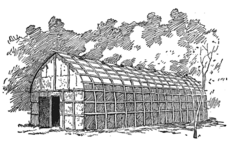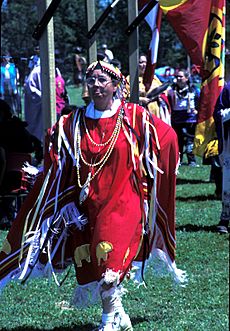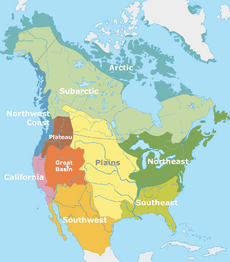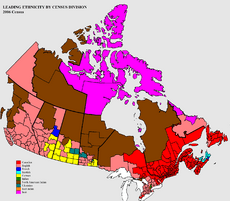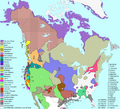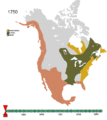First Nations facts for kids

Population distribution of First Nations Canadians by census division, 2021 census
|
|
| Total population | |
|---|---|
| 1,048,400 (2021) 2.83% of the total Canadian population |
|
| Languages | |
|
|
| Religion | |
|
|
| Related ethnic groups | |
| Native Americans, Alaska Natives, Métis |
First Nations (French: Premières Nations) is a term used to identify Indigenous peoples in Canada who are neither Inuit nor Métis. Traditionally, First Nations in Canada were peoples who lived south of the tree line, and mainly south of the Arctic Circle. There are 634 recognized First Nations governments or bands across Canada. Roughly half are located in the provinces of Ontario and British Columbia.
First Nation as a term became officially used by the government beginning in 1980s to replace the term Indian band in referring to groups of Indians with common government and language. The First Nations people had begun to identify by this term during 1970s activism, in order to avoid using the word Indian, which some considered offensive. No legal definition of the term exists.
History
First Nations peoples had settled and established trade routes across what is now Canada by 500 BCE – 1,000 CE. Communities developed, each with its own culture, customs, and character. In the northwest were the Athapaskan-speaking peoples, Slavey, Tłı̨chǫ, Tutchone-speaking peoples, and Tlingit. Along the Pacific coast were the Haida, Tsimshian, Salish, Kwakiutl, Nuu-chah-nulth, Nisga'a and Gitxsan. In the plains were the Blackfoot, Kainai, Sarcee and Northern Peigan. In the northern woodlands were the Cree and Chipewyan. Around the Great Lakes were the Anishinaabe, Algonquin, Iroquois and Wyandot. Along the Atlantic coast were the Beothuk, Maliseet, Innu, Abenaki and Mi'kmaq.
The Blackfoot Confederacy resides in the Great Plains of Montana and Canadian provinces of Alberta, British Columbia and Saskatchewan. The name Blackfoot came from the dye or paint on the bottoms of their leather moccasins. One account claimed that the Blackfoot Confederacies walked through the ashes of prairie fires, which in turn blackened the bottoms of their moccasins. They had migrated onto the Great Plains (where they followed bison herds and cultivated berries and edible roots) from the area of now eastern Canada and the northeastern United States. Historically, they allowed only legitimate traders into their territory, making treaties only when the bison herds were exterminated in the 1870s.
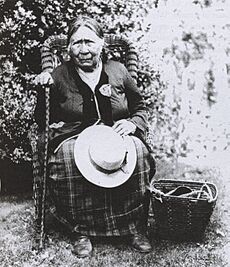
Pre-contact Squamish history is passed on through oral tradition of the Squamish indigenous peoples of the Pacific Northwest Coast. Prior to colonization and the introduction of writing had only oral tradition as a way to transmit stories, law, and knowledge across generations. The writing system established in the 1970s uses the Latin alphabet as a base. Knowledgeable elders have the responsibility to pass historical knowledge to the next generation. People lived and prospered for thousands of years until the Great Flood. In another story, after the Flood, they repopulated from the villages of Schenks and Chekwelp, located at Gibsons. When the water lines receded, the first Squamish came to be. The first man, named Tseḵánchten, built his longhouse in the village, and later on another man named Xelálten, appeared on his longhouse roof and sent by the Creator, or in the Squamish language keke7nex siyam. He called this man his brother. It was from these two men that the population began to rise and the Squamish spread back through their territory.
The Iroquois influence extended from northern New York into what are now southern Ontario and the Montreal area of modern Quebec. The Iroquois Confederacy is, from oral tradition, formed circa 1142. Adept at cultivating the Three Sisters (maize/beans/squash), the Iroquois became powerful because of their confederacy. Gradually the Algonquians adopted agricultural practises enabling larger populations to be sustained.
The Assiniboine were close allies and trading partners of the Cree, engaging in wars against the Gros Ventres alongside them, and later fighting the Blackfoot. A Plains people, they went no further north than the North Saskatchewan River and purchased a great deal of European trade goods through Cree middlemen from the Hudson's Bay Company. The lifestyle of this group was semi-nomadic, and they followed the herds of bison during the warmer months. They traded with European traders, and worked with the Mandan, Hidatsa, and Arikara tribes.
In the earliest oral history, the Algonquins were from the Atlantic coast. Together with other Anicinàpek, they arrived at the "First Stopping Place" near Montreal. While the other Anicinàpe peoples continued their journey up the St. Lawrence River, the Algonquins settled along the Ottawa River (Kitcisìpi), an important highway for commerce, cultural exchange, and transportation. A distinct Algonquin identity, though, was not realized until after the dividing of the Anicinàpek at the "Third Stopping Place", estimated at 2,000 years ago near present-day Detroit.

According to their tradition, and from recordings in birch bark scrolls (wiigwaasabak), Ojibwe (an Algonquian-speaking people) came from the eastern areas of North America, or Turtle Island, and from along the east coast. They traded widely across the continent for thousands of years and knew of the canoe routes west and a land route to the west coast. According to the oral history, seven great miigis (radiant/iridescent) beings appeared to the peoples in the Waabanakiing to teach the peoples of the mide way of life. One of the seven great miigis beings was too spiritually powerful and killed the peoples in the Waabanakiing when the people were in its presence. The six great miigis beings remained to teach while the one returned into the ocean. The six great miigis beings then established doodem (clans) for the peoples in the east. Of these doodem, the five original Anishinaabe doodem were the Wawaazisii (Bullhead), Baswenaazhi (Echo-maker, i.e., Crane), Aan'aawenh (Pintail Duck), Nooke (Tender, i.e., Bear) and Moozoonsii (Little Moose), then these six miigis beings returned into the ocean as well. If the seventh miigis being stayed, it would have established the Thunderbird doodem.
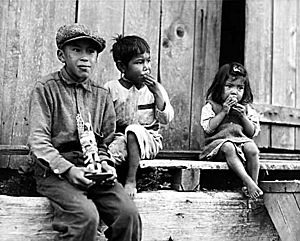
The Nuu-chah-nulth are one of the Indigenous peoples of the Pacific Northwest Coast. The term Nuu-chah-nulth is used to describe fifteen separate but related First Nations, such as the Tla-o-qui-aht First Nations, Ehattesaht First Nation and Hesquiaht First Nation whose traditional home is on the west coast of Vancouver Island. In pre-contact and early post-contact times, the number of nations was much greater, but smallpox and other consequences of contact resulted in the disappearance of groups, and the absorption of others into neighbouring groups. The Nuu-chah-nulth are relations of the Kwakwaka'wakw, the Haisla, and the Ditidaht. The Nuu-chah-nulth language is part of the Wakashan language group.
In 1999 the discovery of the body of Kwäday Dän Ts'ìnchi provided archaeologists with significant information on indigenous tribal life prior to extensive European contact. Kwäday Dän Ts'ìnchi (meaning "Long Ago Person Found" in Southern Tutchone), or "Canadian Ice Man", is a naturally mummified body that a group of hunters found in Tatshenshini-Alsek Provincial Park in British Columbia. Radiocarbon dating of artifacts found with the body placed the age of the find between 1450 AD and 1700 AD. Genetic testing showed that he was a member of the Champagne and Aishihik First Nations.
Culture
National Aboriginal Day recognizes the cultures and contributions of Aboriginal peoples of Canada. There are currently over 600 recognized First Nations governments or bands encompassing 1,172,790 2006 people spread across Canada with distinctive Aboriginal cultures, languages, art, and music.
Food
Indigenous food in particular is considered very Canadian. Foods such as bannock, moose, deer, bison, pemmican, maple taffy, and Métis stews such as barley stew are all either traditional Indigenous foods or originated in Canada with roots in Indigenous cuisines, and are eaten widely throughout the country.
Other foods are fish, polar bears, musk ox, and caribou.
Music
The First Nations peoples of Canada comprise diverse ethnic groups, each with their own musical traditions. There are general similarities in the music, but is usually social (public) or ceremonial (private). Public, social music may be dance music accompanied by rattles and drums. Private, ceremonial music includes vocal songs with accompaniment on percussion, used to mark occasions like Midewiwin ceremonies and Sun Dances.
Traditionally, Aboriginal peoples used the materials at hand to make their instruments for centuries before Europeans immigrated to Canada. First Nations people made gourds and animal horns into rattles, which were elaborately carved and beautifully painted. In woodland areas, they made horns of birch bark and drumsticks of carved antlers and wood. Traditional percussion instruments such as drums were generally made of carved wood and animal hides. These musical instruments provide the background for songs, and songs are the background for dances. Traditional First Nations people consider song and dance to be sacred. For years after Europeans came to Canada, First Nations people were forbidden to practice their ceremonies.
Languages
Today, there are over thirty different languages spoken by indigenous people, most of which are spoken only in Canada. Many are in decline. Those with the most speakers include Anishinaabe and Cree (together totalling up to 150,000 speakers); Inuktitut with about 29,000 speakers in the Northwest Territories, Nunavut, Nunavik (Northern Quebec), and Nunatsiavut (Northern Labrador); and Mi'kmaq, with around 8,500 speakers, mostly in Eastern Canada. Many Aboriginal peoples have lost their native languages and often all but surviving elders speak English or French as their first language.
Two of Canada's territories give official status to native languages. In Nunavut, Inuktitut and Inuinnaqtun are official languages alongside English and French, and Inuktitut is a common vehicular language in government. In the Northwest Territories, the Official Languages Act declares that there are eleven different languages: Chipewyan, Cree, English, French, Gwich’in, Inuinnaqtun, Inuktitut, Inuvialuktun, North Slavey, South Slavey and Tłįchǫ. Besides English and French, these languages are not vehicular in government; official status entitles citizens to receive services in them on request and to deal with the government in them.
Art

Today, there are over thirty different languages spoken by indigenous people, most of which are spoken only in Canada. Many are in decline. Those with the most speakers include Anishinaabe and Cree (together totalling up to 150,000 speakers); Inuktitut with about 29,000 speakers in the Northwest Territories, Nunavut, Nunavik (Northern Quebec), and Nunatsiavut (Northern Labrador); and Mi'kmaq, with around 8,500 speakers, mostly in Eastern Canada. Many Aboriginal peoples have lost their native languages and often all but surviving elders speak English or French as their first language.
Two of Canada's territories give official status to native languages. In Nunavut, Inuktitut and Inuinnaqtun are official languages alongside English and French, and Inuktitut is a common vehicular language in government. In the Northwest Territories, the Official Languages Act declares that there are eleven different languages: Chipewyan, Cree, English, French, Gwich'in, Inuinnaqtun, Inuktitut, Inuvialuktun, North Slavey, South Slavey and Tłįchǫ. Besides English and French, these languages are not vehicular in government; official status entitles citizens to receive services in them on request and to deal with the government in them.
Demographics
In the 20th century, the First Nations population of Canada increased tenfold. Between 1900 and 1950 the population grew only by 29% but after the 1960s the infant mortality level on reserves dropped and the population grew by 161%. Since the 1980s, the number of First Nations babies more than doubled and currently almost half of the First Nations population is under the age of 25. As a result, the First Nations population of Canada is expected to increase in the coming decades.
In 2021, there were 1,807,250 Aboriginal people in Canada, accounting for 5.0% of the total population. There are distinct First Nations in Canada, originating across the country. Indian reserves, established in Canadian law by treaties such as Treaty 7, are the very limited contemporary lands of First Nations recognized by the non-indigenous governments. A few reserves exist within cities, such as the Opawikoscikan Reserve in Prince Albert, Wendake in Quebec City or Stony Plain 135 in the Edmonton Capital Region. There are more reserves in Canada than there are First Nations, as First Nations were ceded multiple reserves by treaty.
First Nations can be grouped into cultural areas based on their ancestors' primary lifeway, or occupation, at the time of European contact. These culture areas correspond closely with physical and ecological regions of Canada.
Ethnographers commonly classify indigenous peoples of the Americas in the United States and Canada into ten geographical regions with shared cultural traits (called cultural areas). The Canadian (in whole or in part) regions are Arctic, Subarctic, Northeast Woodlands, Plains, and Plateau. See the individual article on each tribe, band society or First Nation.
The Indigenous peoples of the Pacific Northwest Coast communities centred around ocean and river fishing; in the interior of British Columbia, hunting and gathering and river fishing. In both of these areas, salmon was of chief importance. For the people of the plains, bison hunting was the primary activity. In the subarctic forest, other species such as the moose were more important. For peoples near the Great Lakes and the St. Lawrence River, shifting agriculture was practised, including the raising of maize, beans, and squash.
Today, Aboriginal people work in a variety of occupations and live outside their ancestral homes. The traditional cultures of their ancestors, shaped by nature, still exert a strong influence on their culture, from spirituality to political attitudes.
| Province/Territory | 1921 | 1931 | 1941 | 1951 | 1961 | 1971 | 1981 | 1996 | 2011 | 2016 | 2021 |
|---|---|---|---|---|---|---|---|---|---|---|---|
| Newfoundland and Labrador | - | - | - | 358 | 596 | 1225 | 3230 | 5430 | 19315 | 28375 | 28435 |
| Prince Edward Island | 235 | 233 | 258 | 257 | 236 | 315 | 440 | 825 | 1520 | 1875 | 2165 |
| Nova Scotia | 2048 | 2191 | 2063 | 2717 | 3267 | 4475 | 6305 | 11340 | 21895 | 25830 | 28050 |
| New Brunswick | 1331 | 1685 | 1939 | 2255 | 2921 | 3915 | 4610 | 9180 | 16120 | 17575 | 20955 |
| Quebec | 11566 | 12312 | 11863 | 14631 | 18876 | 32835 | 46855 | 47600 | 82420 | 92655 | 116555 |
| Ontario | 26654 | 30368 | 30336 | 37370 | 47862 | 62415 | 83860 | 118830 | 201105 | 236685 | 251030 |
| Manitoba | 13869 | 15417 | 15473 | 21024 | 29219 | 43035 | 59920 | 82990 | 114225 | 130510 | 134890 |
| Saskatchewan | 12914 | 15268 | 13384 | 22250 | 30628 | 40475 | 54720 | 75205 | 103205 | 114570 | 121175 |
| Alberta | 14557 | 15258 | 12565 | 21163 | 28469 | 44545 | 60005 | 72645 | 116670 | 136590 | 145640 |
| British Columbia | 22377 | 24599 | 24875 | 28478 | 38789 | 52220 | 64695 | 113315 | 155020 | 172520 | 180085 |
| Yukon | 1390 | 1543 | 1508 | 1533 | 2167 | 2580 | 3415 | 5530 | 6590 | 6690 | 6935 |
| Northwest Territories | 3873 | 4046 | 4052 | 3838 | 5256 | 7180 | 7635 | 11400 | 13345 | 13180 | 12315 |
| Nunavut | - | - | - | - | - | - | - | - | 130 | 190 | 180 |
| Canada total | 110,814 | 122,920 | 118,316 | 155,874 | 208,286 | 295,215 | 395,690 | 554,290 | 851,560 | 977,230 | 1,048,400 |
Other pages
Images for kids
-
Linguistic areas of North American Indigenous peoples at the time of European contact.
-
Assiniboine hunting buffalo, c. 1851
-
Pitikwahanapiwiyin (Poundmaker)
-
Mi'kmaq Grand Chief Jacques-Pierre Peminuit Paul (3rd from left with beard) meets Governor General of Canada, Marquess of Lorne, Red Chamber, Province House, Halifax, Nova Scotia, 1879
-
Buying provisions, Hudson's Bay territory, 1870s
-
Ethnomusicologist Frances Densmore recording Blackfoot chief Mountain Chief (1916)
-
Honourable David Laird explaining terms of Treaty #8, Fort Vermilion, 1899


